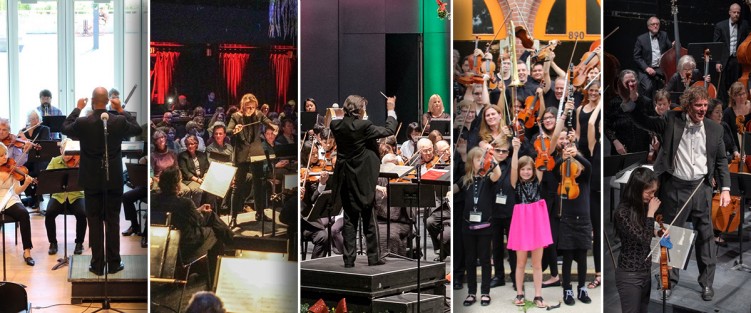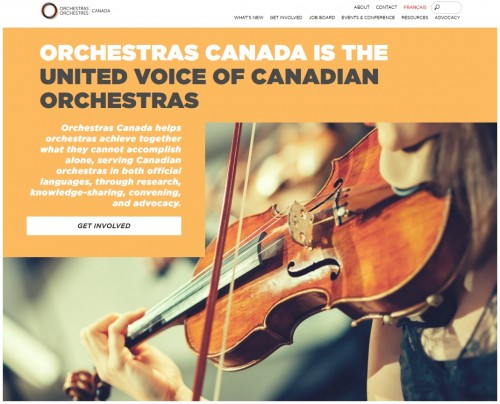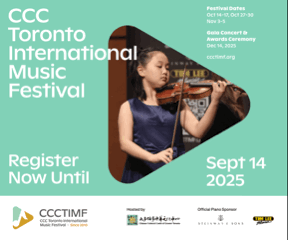 Every year for almost two decades, the surest sign of spring at The WholeNote has been the steady stream of canaries, with early birds starting to arrive at our office just before March break, to latecomers, just under the wire, straggling in just before our mid-April deadline for the May issue. (Somewhere between 140 and 150 of them by the time it’s done.)
Every year for almost two decades, the surest sign of spring at The WholeNote has been the steady stream of canaries, with early birds starting to arrive at our office just before March break, to latecomers, just under the wire, straggling in just before our mid-April deadline for the May issue. (Somewhere between 140 and 150 of them by the time it’s done.)
These “canaries,” as faithful WholeNote readers know, are not the avian kind, but rather the individual short profiles (120 words or so) submitted by Ontario choirs for inclusion in our annual Canary Pages – the name we give to our annual directory of Ontario choirs.
The directory, now in its 18th year, always appears in print in our May magazine and remains online as a resource, year round, on our website. It’s an extraordinarily eclectic read, because any choir active in our region can join, amateur or professional or a mix of both, auditioned or not, geared to the social or spiritual pleasures of regular meeting to sing, or to the focused pursuit of excellence in public performance. Its main purpose is to talk about the opportunities for singing that exist in our region, at all ages and levels of skill.
For me this directory affirms the way music making contributes to a sense of community and how it affirms the human need (stronger than all the digital isolationism society tempts us with), to come together for the purpose of participating in the making and sharing of live music.
Every spring, without fail, the canaries flock to The WholeNote, and every spring, without fail, as the canaries arrive, someone on our team (usually me) says “One of these years we should try to do the same thing for orchestras, because orchestras fulfil the same role as choirs do.”
And every spring, because by then it’s too late to get organized to do it properly, we say “Yes we should, so maybe next year.”
This year, at that moment, I decide instead to reach out to Katherine Carleton, executive director of Orchestras Canada. The last time we talked must have been even longer ago than I thought, because at that time their offices were on College Street, just west of Bathurst, ten minutes’ walk from The WholeNote office. This time, by contrast, we find ourselves chatting by phone, two area codes apart: Orchestras Canada, she tells me, relocated its headquarters to Peterborough in 2014!
“Was the 2014 move from downtown Toronto to Peterborough a case of Orchestras Canada following you there, or you following it?” I ask. “It followed me,” she says. “One of those cases of family members reaching a time of life where they needed one of us closer to home.”
 Carleton, who has been executive director of Orchestras Canada since 2005, grew up in Peterborough, and made her way to Orchestras Canada via, among other things, a stint as a granting officer in the music section of the Ontario Arts Council in the early 1990s, “a time when there was adequate funding and a strong feeling that the health of orchestras was vital to healthy cultural life. Large or small, they were all of interest to us,” she says.
Carleton, who has been executive director of Orchestras Canada since 2005, grew up in Peterborough, and made her way to Orchestras Canada via, among other things, a stint as a granting officer in the music section of the Ontario Arts Council in the early 1990s, “a time when there was adequate funding and a strong feeling that the health of orchestras was vital to healthy cultural life. Large or small, they were all of interest to us,” she says.
“So, has the change in location from College and Bathurst to Peterborough also changed your perception of the role of the organization?” I ask. “I mean, is it possible for a national arts service organization to thrive outside of the 18 blocks of downtown Toronto that we all know the world pivots around?” (Her laugh, in response, has at least a couple of my co-workers turning their heads, wondering what I could have said, on the topic of arts service organizations, funny enough to elicit that response.)
“No, and for a couple of reasons,” she says. “First is that the organization, and this includes my predecessors, as well as in my time here, has always thought nationally, which means being equally available to all our members. OC has 130 member orchestras, none in the territories, but member orchestras in every Canadian province. These days we should be able to operate from anywhere where there’s high-speed internet. Is my life as a concertgoer more challenging now, from a mindset of ‘gosh it’s easy to get to Roy Thomson Hall or Jeanne Lamon, or Koerner because it’s on my way home’? Sure. But in terms of OC as an organization, no. As I said, the focus has always been on orchestras nationally, reinforced by a board of directors that is recruited from across the country. Especially for all the conversations we’re engaging in these days, everything we do is carefully curated so we have representation from orchestras of all sizes and types, and from all parts of the country.”
Of Orchestras Canada’s current 130 members, 65 are in Ontario, with 39 of those being outside of the GTA. And of those 39, two, the Peterborough Symphony and the Kawartha Youth Orchestra, are right in Carleton’s back yard. “Does being up close and personal with their particular challenges as smal-town orchestras put a different slant on things?” I ask.
“No, and I’ll tell you why,” she says. “But before I do, I need to out myself, as a performing member of the Peterborough Symphony (clarinet and bass clarinet). ‘When asked to serve, I do so.’ That kind of thing. And I also teach a number of the members of both the Kawartha Youth Orchestra and their Junior Youth Orchestra, privately. So my sense of them is definitely up close and personal. But as for how being here impacts on my slant on things, it really truly doesn’t. As I mentioned, my insights and attitudes go right back to my Arts Council days, at a time when there was a strong feeling that orchestras were vital to community health right across the province, whether small budget or major institutions. And Orchestras Canada has always cared and understood the same thing. These are things I have pursued right through my own life, so it’s hard to separate where the organization stands from where I do in regard to them – whether the organization is responding to me as executive director or where it’s simply that in taking this job I found exactly the right work for me. The Venn diagram in this case is truly a circle.”
“I did some digging into your website before calling you,” I say, “and a couple of things really jumped out at me. One was the information on the site the upcoming OC conference in Ottawa, June 12 to 14, which I’d like to come back to, because the title of the conference dovetails with my main reason for getting in touch. The other is the changes I noticed to the way the member orchestra directory on the OC site is organized.”
The directory in question has gone through some really interesting changes since I last looked at it as carefully as I did while preparing for this interview. It’s deceptively simple: a five-column spreadsheet: name of member; province; membership type; annual revenues; and, last, a column headed simply “Go to Website.”
“I remember, back in the day, that the column called ‘annual revenues’ used to be something way more complex” I say. “As I recall, you used to classify orchestras by type – regional, community, large, middle-sized, small – things like that. And I remember trying to persuade you that you should partner with us on a directory something like the ones we do, where the members submit short profiles about who they are and what they do.”
“Yes” she says, “I remember that, and thinking long and hard about it. But we went a different direction, putting the onus on members to keep their own information up to date on their websites.” As for the change from describing orchestras as ‘community’ or ‘regional’ to grouping them by annual revenues, she explains, the beginning of that shift goes back to project funding they got from the Ontario Arts Council. (“I’m not going to even try to put a year on it,” she says.) The money was given, in the terminology of the day, to study “the situation, interests and needs of smaller budget orchestras” in Ontario. “We started out, perhaps naively in retrospect, calling them community orchestras, and put together a research plan that involved travelling around to five or six parts of the province – and having regional meetings with folks from these orchestras.”
It was an extraordinarily rich series of conversations, she says: What became abundantly clear was that there were more differences among orchestras with “small budgets” (revenues from $0 to $600,000 a year), than there were among orchestras with “large budgets” (revenues from $650,000 to $33 million). “There was every shade of music making in that $0 to $600,000 range” she says, “from orchestras where only the conductor gets an honorarium through to fully professional ensembles with very short seasons, but all fitting within that so-called ‘small budget’ space we had preemptively defined as ‘community orchestras.’”
 It became clear, from this exercise, that trying to define the concept of a “community orchestra” based on budget ran the risk of making the designation so amorphous as not to be useful, or else trying to refine it further, to those groups with very little professional participation, with the danger that “community orchestra” would become almost a pejorative term – “taken as symptomatic of volunteer bumbling rather than ‘we are darned proud of being called that’.”
It became clear, from this exercise, that trying to define the concept of a “community orchestra” based on budget ran the risk of making the designation so amorphous as not to be useful, or else trying to refine it further, to those groups with very little professional participation, with the danger that “community orchestra” would become almost a pejorative term – “taken as symptomatic of volunteer bumbling rather than ‘we are darned proud of being called that’.”
The new way of designating orchestras in the directory, purely by annual revenue, removes a layer of artistic value judgment from the equation.
Viewed in this light, the Orchestras Canada member directory in its current form becomes a much more nuanced resource, amenable to searching and sorting in all kinds of ways; and with orchestras rising to the challenge of keeping their own websites up to date, (something that, from my perusal of the 65 Ontario orchestras in the directory, the vast majority are managing to do) it makes for fascinating reading.
Removal of “community orchestra” as a loaded label from the Orchestras Canada member directory is an improvement there, but the word community itself remains fundamental to what Orchestras Canada is about, as one digs through the resources and information on the website. The word may have ceased to be useful in describing what orchestras are, but that creates, if anything, an even greater responsibility for OC and the constituency it serves to dig even more deeply into what the term “community” is useful for in talking about the always uncertain future of our orchestras. And that’s where the upcoming June 12 to 14 Orchestras Canada conference at the National Arts Centre in Ottawa, titled Designing the 21st Century Orchestra: Embedding Canadian Orchestras in Canadian Communities, promises to be rather useful.
The notion of “embedding orchestras in communities” is catchy, but not if it becomes a lazy catch-all. It is ultimately only useful as a starting point for minutely specific exploration of what the two-way chemistry that needs to exist between communities and their orchestras actually consists of. Carleton thrives on this kind of detailed delving, fascinated by what it can uncover.
“I’ll give you an example,” she says. “One of the fascinating conversations we have been involved with lately – quite amazing to me actually – led to becoming aware, among smaller groups with volunteer musicians, of the competition among these orchestras for the finest volunteer musicians. The clear sense from these players is that if the orchestra is not giving them the opportunity to play the repertoire that they want to in a setting that is congenial for their artistic goals and standards, musicians will go orchestra shopping; so when orchestras like that are asking the question What is our definition of the community we serve? the musicians themselves are going to be very high on that list, because if the entire trombone section walks, and we can’t attract trombones, then what do we do?”
“So what are some of the other good questions, like that one, then?” I ask.
“The question of where excellence fits in,” she says, “that’s a good one. Poor old Beethoven, you know. He often comes in for a bit of a beating in conversations like this. A bit ironic, really. We’ll be sitting around a table and someone will sometimes say, ‘Is our purpose to play Beethoven better every time that the group has the honour of engaging with that music?’ And sometimes it may simply be fine to say YES. That is our job, that is our role, that is our goal as an organization. But maybe there are times where it needs to be a ‘Yes, ... and’ as the improvisers say. Or maybe a ‘Yes … until’ as in ‘’Yes, until it becomes so highly prioritized, in some cases, that volunteer musicians are no longer welcome.’”
“And more?” I ask.
“Perhaps most important, because orchestras are complex contraptions, with lots of people with strong opinions, who are the people involved in these conversations about which way forward? What are the differing perspectives that are coming to the table? The musicians, highly trained and with very specific skills: how are they involved? Board and staff. Volunteers? Is there a living conversation at the place?”
A pause … and then, “This is not dull work,” she says.
David Perlman can be reached at publisher@thewholenote.com.



